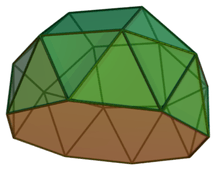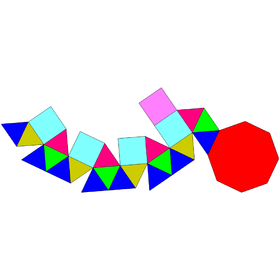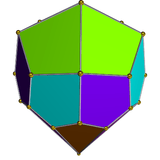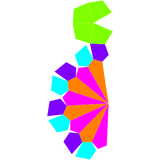Gyroelongated square cupola
In geometry, the gyroelongated square cupola is one of the Johnson solids (J23). As the name suggests, it can be constructed by gyroelongating a square cupola (J4) by attaching an octagonal antiprism to its base. It can also be seen as a gyroelongated square bicupola (J45) with one square bicupola removed.
| Gyroelongated square cupola | |
|---|---|
 | |
| Type | Johnson J22 - J23 - J24 |
| Faces | 3x4+8 triangles 1+4 squares 1 octagon |
| Edges | 44 |
| Vertices | 20 |
| Vertex configuration | 4(3.43) 2.4(33.8) 8(34.4) |
| Symmetry group | C4v |
| Dual polyhedron | - |
| Properties | convex |
| Net | |
 | |

An unfolded gyroelongated square cupola

An unfolded gyroelongated square cupola, faces colored by symmetry
A Johnson solid is one of 92 strictly convex polyhedra that is composed of regular polygon faces but are not uniform polyhedra (that is, they are not Platonic solids, Archimedean solids, prisms, or antiprisms). They were named by Norman Johnson, who first listed these polyhedra in 1966.[1]
Dual polyhedron
The dual of the gyroelongated square cupola has 25 faces: 8 kites, 4 rhombi, and 8 pentagons.
| Dual gyroelongated square cupola | Net of dual |
|---|---|
 |
 |
External links
- Johnson, Norman W. (1966), "Convex polyhedra with regular faces", Canadian Journal of Mathematics, 18: 169–200, doi:10.4153/cjm-1966-021-8, MR 0185507, Zbl 0132.14603.
This article is issued from Wikipedia. The text is licensed under Creative Commons - Attribution - Sharealike. Additional terms may apply for the media files.